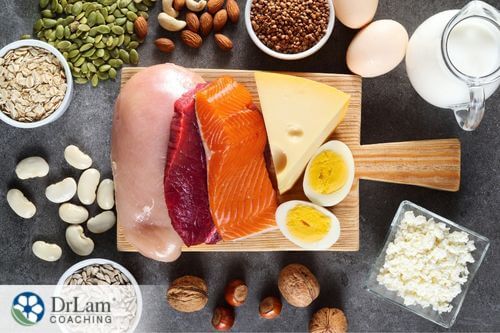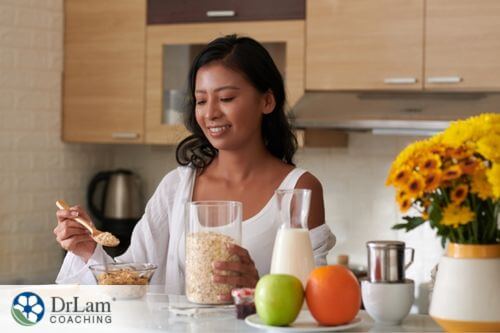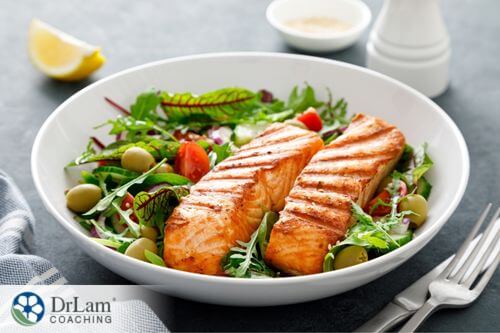 Food is more than just the fuel needed to give your body energy to function. It also provides the nutrients needed to carry out many vital functions in the brain, organs, muscles, bones, cells, and more. Healthy eating provides us with these nutrients.
Food is more than just the fuel needed to give your body energy to function. It also provides the nutrients needed to carry out many vital functions in the brain, organs, muscles, bones, cells, and more. Healthy eating provides us with these nutrients.
Healthy eating does not mean you need to subsist on a diet of asparagus, lettuce, and tomatoes. It means you need to provide your body with a wide range of foods to cover all your nutritional needs. And to do this without overeating, it means cutting out certain foods while concentrating on others. It also does not mean that your food bill has to be astronomically high either! Rather, it just means making the right food choices when you are grocery shopping and tailoring your meal plans to include certain foods. Also, while one should try to stick to a healthy eating plan, it doesn't mean you can't cheat occasionally too. The occasional slice of pizza or chocolate bar is still okay, as long as it is still occaisional.
To get a wide range of foods, there are five major food groups that you should try to incorporate into your diet on a daily basis.
These five food groups are necessary for healthy eating. These foods are grouped together because they provide your body with similar key nutrients. These five food groups are: vegetables, fruits, protein, grains, and dairy products.
When purchasing fruits, vegetables, or meat, always look for the organic option. Organic foods do not contain chemicals from herbicides or manufactured fertilizers, which can affect your health.
Vegetables form one of the most diverse food groups. They come in a large variety of colors, textures, and flavors. Vegetables also contain a vast variety of vitamins, minerals, and other nutrients, as well as carbohydrates. They are also an important fiber source. Furthermore, you can group them into leafy greens, red or orange vegetables, legumes, and starches.
Leafy greens include the likes of collard greens, spinach, broccoli, kale, and cabbage. Corn, potatoes, and green peas are starchy vegetables, while carrots, squash, and sweet potato are examples of red and orange vegetables. Legumes can also be regarded as part of the protein food group. Good examples include soybeans, chickpeas, kidney beans, and black beans.
Fruits are a sweet alternative to chocolates, cake, or other sugary foods. They contain many beneficial nutrients and supply fiber to your diet as well. What is more, their variety is astounding. You can pick from citrus fruits, stone fruits, berries, and more. Citrus fruits include lemons, oranges, grapefruits, and tangerines. Stone fruits include cherries, apricots, plums, and peaches. There are also apples, bananas, figs, grapes, and pineapples, as well as many different berry varieties.
Most Americans do not have enough fiber in their diet. Not only do fruits provide the fiber that improves digestion, but they also contain carbohydrates and simple sugars. Most of your fruit intake should consist of whole fruits. If whole fresh fruits are not an option, you can opt for canned, frozen, or dried fruit. Do, however, always seek out the option containing the lowest amount of sugar.
 Even vegetarians and vegans need proteins in their diet. Your body uses proteins to repair tissues and fight infections. Your body also needs proteins for energy. When choosing red meat or poultry, opt for the low-fat, i.e., lean meat option. Other good protein sources include nuts, soy products, seeds, beans, eggs, and seafood.
Even vegetarians and vegans need proteins in their diet. Your body uses proteins to repair tissues and fight infections. Your body also needs proteins for energy. When choosing red meat or poultry, opt for the low-fat, i.e., lean meat option. Other good protein sources include nuts, soy products, seeds, beans, eggs, and seafood.
Plant protein sources are rich in fiber and other nutrients while containing no cholesterol. They also have a lower saturated fat content.
With regards to seafood, you should ideally try to eat a serving of fish about twice a week. Seafood is not only a good protein source, but it also contains omega-3 fatty acids. Omega-3 fatty acids promote heart health. Good choices include sardines, salmon, trout, and anchovies. If unable to purchase fresh fish, canned options make a good second choice. Just remember fish often contains mercury, so don't overdo it.
Grains include wheat, barley, cornmeal, rice, oats, and rye. These grains are often ground into flour to make pasta, bread, tortillas, grits, and even breakfast cereal. Corn is also technically a grain, as is quinoa.
Grains are used in making most breakfast cereals. If purchasing a breakfast cereal, please note the presence of added sugars or saturated fats. Even a breakfast cereal labeled as low-fat may have a lot of sugar added. Something like rolled oats is a better breakfast option.
When it comes to healthy eating, opting for whole grains whenever possible is the best option. Whole grains contain higher levels of iron, B vitamins, and fiber. Good examples include bulgur wheat, brown rice, whole wheat, and whole oats.
Much of our grain intake comes from refined grain products. These refined grains have a longer shelf life on the one hand, but the refining process robs them of fiber and nutrients. Examples of refined grains include white flour, white rice, and white bread.
Dairy products promote bone health. They are a rich source of calcium, vitamin D, and potassium. But they can also have a high-fat content. So, if you want to look after your heart health, you can opt for either low-fat or fat-free options. They still contain the needed nutrients.
If choosing yogurt, look at the sugar content on the label. Many yogurt suppliers add sugar to their low-fat yogurt options. Consider plain varieties instead and sweeten them yourself.
However, many vegans or lactose-intolerant people may opt not to use dairy products. Fortunately, they can choose from other alternatives to get the needed nutrients.
For example, fortified soy milk has added calcium, vitamin A, and vitamin D. You can also look into coconut milk, rice milk, oat milk, or almond milk. Many of these may contain added calcium but may not contain the protein commonly found in milk. When considering one of these alternatives, do check the label for added sugars. Choose either the low-sugar or unsweetened options.
But what about our beverages, oils, and sugars? There are good ways to use these foods in your diet as part of healthy eating as well.
 The most important beverage is water. Water makes up 60% of an adult male and 55% of an adult female’s body mass. It plays a key role in all body processes. For example, it carries oxygen, nutrients, and waste either to or from cells and organs. It also helps cushion your joints and protects organs and tissues from damage or shocks. Furthermore, it helps your body with temperature regulation. The best thing about water is that it contains zero calories. If you do not like the taste of water, consider adding a teaspoon of lemon juice. Doing so adds a little vitamin C to the drink and adds some flavor. So, drink the water!
The most important beverage is water. Water makes up 60% of an adult male and 55% of an adult female’s body mass. It plays a key role in all body processes. For example, it carries oxygen, nutrients, and waste either to or from cells and organs. It also helps cushion your joints and protects organs and tissues from damage or shocks. Furthermore, it helps your body with temperature regulation. The best thing about water is that it contains zero calories. If you do not like the taste of water, consider adding a teaspoon of lemon juice. Doing so adds a little vitamin C to the drink and adds some flavor. So, drink the water!
Coffee or tea (depending on the type of tea) do not have many calories, but they may have stimulants that could add to your body’s stress load. Also, when adding sugar or cream, you could provide your body with extra calories it may not need.
Soda, energy drinks, and sweetened water often have a very high sugar content which ups the number of calories you consume. Sugar also adds to your body’s stress load and may end up stored in your body as fat.
Alcohol does not contain many nutrients, is often high in calories, and should be used in moderation. Too much alcohol can increase your body’s stress load and harm your liver.
Although high in calories, many oils contain beneficial nutrients. Vitamin E is a good example. When choosing an oil, read the label. You want to look for those containing polyunsaturated or monounsaturated fats. Considered good fats, they provide your body with energy and promote vitamin absorption. Examples of these include olive oil, grapeseed oil, flaxseed oil, and avocado oil.
Trans fats harm your body and health and should be completely avoided. It's a good idea to keep saturated fat levels low, as these can also harm your heart health.
When practicing the principles of healthy eating, your body gets all the sugar it needs from the food you eat. Fruit, for example, contains simple sugars. You should ideally stay away from any foods high in sugar content. These include cookies, cakes, sweets, and many food products listed as low-fat. Many low-fat foods have high sugar content. High-sugar foods often have the following on their labels to try and make you see them as ‘healthy’:
These do not classify as healthy eating food options.
Bioenergetics refers to the flow of energy throughout your body. Every cell, organ, and body process needs energy to work correctly and for metabolism, growth, and development.
The bioenergetic process starts with the nutrients it gets from your diet. These nutrients are then converted into macromolecule precursors, i.e., amino acids, simple sugars, and nucleotides. Depending on their combination, these macromolecule precursors form protein, nucleic acids, and polysaccharides. These perform specialized functions throughout your body.
Your Bioenergetic Circuit itself is made up of three organs: the liver, thyroid gland, and pancreas. The circuit plays a key role as part of your body’s NeuroEndoMetabolic (NEM) stress response. The NEM stress response causes a cascade of events influencing every organ system and process in your body when you experience stress.
While all system functions return to normal once stress passes, prolonged stress may have a detrimental effect on your health. It may also affect how your body processes energy. In so doing, you may develop. This can lead to adrenal fatigue because the adrenals have difficulty keeping up with the demand for stress hormone production as required by an ongoing NEM stress response.
With regards to your Bioenergetics Circuit, your liver, thyroid, and pancreas may become impaired. These three organs are the main sites of energy production in your body. By practicing healthy eating habits, the nutrients provided may support their health and function. In so doing, your diet may help promote adrenal health and resilience through stress as well.
 Healthy eating servings depend on your age and sex.
Healthy eating servings depend on your age and sex.
Healthy women over nineteen years of age should try and follow the following recommendations. However, pregnant women need to eat more due to the demands of pregnancy on their bodies. Otherwise, these are good guidelines for women:
With regards to men over the age of nineteen years, the following recommendations serve as good guidelines to follow:
One person’s idea of a food serving differs from another, but it's a good idea to keep some of these portion sizes in mind for healthy eating. A good measure of one food serving size is as follows:
Grains:
Vegetables:
Fruit:
You should use dried fruit sparingly, as dried fruit has higher sugar levels than fresh fruit. It is also easier to eat more than your daily suggested intake. When drinking fruit juice, half a cup makes a serving. Opt for no-sugar-added juice options.
Dairy:
If using a milk substitute like soy milk, for example, one cup makes a serving.
Proteins:
As a rule of thumb, your red meat size should ideally be no larger than the size of your hand. Healthy eating portions follow:
Breakfast is the time to fuel up for the morning. A cooked cereal, protein like egg, and a dairy serving like yogurt are a good start to the day. You could also consider ricotta cheese on whole wheat toast, or a plant-based protein option. Have it with an apple or banana for one fruit serving for the day.
Lunchtime is a good time to fuel up so you have energy for the afternoon. Many people tend to tire during this period. Salad is a good food choice, as you can get in a serving of leafy greens topped with some protein. Good protein choices include chicken, boiled egg, chickpeas, or some canned cannelloni beans. You can add as many fresh vegetables to your salad as you like. You could also consider a bowl of homemade vegetable soup as a good lunchtime choice. If you love your meat, lunch is a suitable time to consume your major protein serving of the day.
 You do not need as many calories in the evening as you do throughout the day. So, try to lighten your food intake. If you want to do protein in the evening, opt for something light such as grilled chicken or fish. Also, make sure to use up your fruit and vegetable servings!
You do not need as many calories in the evening as you do throughout the day. So, try to lighten your food intake. If you want to do protein in the evening, opt for something light such as grilled chicken or fish. Also, make sure to use up your fruit and vegetable servings!
You can eat your fresh fruit servings any time throughout the day. You can add it to your morning yogurt, for example, or consider it a snack between meals. And if hunger pangs strike between meals, consider munching on a small handful of nuts or fruit.
Healthy eating practices give your body the fuel it needs to function properly, no matter what time of day. It may also help protect you against certain health issues. The key is to follow serving size guidelines for each of the five food groups: vegetables, fruit, grains, proteins, and dairy. By cutting down on sugary or processed foods and limiting your alcohol intake, healthy eating may help with weight management as well.
If you would like to know more about healthy eating practices, the team at Dr. Lam Coaching can help. We offer a free** no-obligation phone consultation at +1 (626) 571-1234 where we will privately address your concerns. You can also send us a question through the Ask Your Doctor system by clicking here.
Healthy eating provides your body with the vitamins, minerals, and nutrients it needs to work efficiently and effectively. This may promote adrenal health because the various body systems get the nutrients needed at a cellular level.
